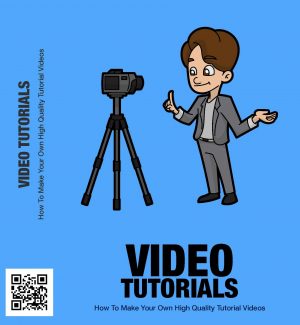
 License Type: Personal Use
License Type: Personal Use  File Type: ZIP
File Type: ZIP
 SKU: 61923
SKU: 61923  Shipping: Online Download
Shipping: Online Download
Sample Content Preview
Introduction
If you aren't using videos to market your business, why not? Anyone with a smartphone can make a decent video because the cameras and microphones on today’s phones are close in quality to basic digital cameras of just a few years ago. You can employ professionals to handle video creation for your company, but it is not necessary to do so. That is because the audience you are trying to reach much prefers short, to the point, simple to understand videos as opposed to a longer video.
A video of 45 to 90 seconds can convey a lot about a product or service, and it doesn't take up much of your prospects' valuable time. According to Cisco, a global technology company, "69% of consumer Internet traffic will be video" by the year 2017.
Guess what? It's 2017, and video is everywhere.
WyzOwl is a company that makes explainer videos. They point to research that shows a full 69% of web surfers who are considering purchasing a product or service prefer video over text as a marketing medium. In another study, 70% of video viewers shared a brand's video through email or on social media.
Also, 80% of consumers state that demonstration videos or video tutorials " ... are helpful when making purchases".
That last stat should really grab you if you are selling anything and you have an online presence. Posting videos to the Internet can be done for free or very little money, and if 8 out of every 10 of your prospects believe a video tutorial will help them make a purchasing decision, it is time for you to get some videos in front of their eyeballs. In this report on how to create great video tutorials, you will learn the "sweet spot" video length to maximize viewership and conversions. You will find out how you can get started making how-to videos and explainer videos right away, with a minimal investment. You will learn video marketing secrets the pros use, why it is oh so important to include a call to action in every video you create, and how to create engaging tutorial videos with nothing more than your smartphone.
You will discover how to write video scripts, how many words per minute your videos should contain, and the top free and paid video creation services. Everything you need to know to record, distribute and benefit from high-quality tutorial videos is now yours.
Ready to get started?
Let's begin by looking at the overall step-by-step process you are going to be following to create video tutorials that help grow your business. Then we will look at the components of those individual steps in detail, provide some technological resources, applications, and websites that make video creation easy, and then cover a few miscellaneous video production tips the pros use.
The Simple 4-Step Process for Making a Video Tutorial
Sometimes marketers make things harder than they need to be. If you have never recorded a tutorial video before, you may be drawing an outline that is long and confusing. It is only necessary to follow the 4-step process listed here to make an effective tutorial video.
Step 1 – Write Your Video Script
A lot of first-time video creators record videos without a dedicated script in place. They know their products and services so well that they believe they can simply hit "record", and begin to explain a step-by-step process or tutorial. While this may be true for a very limited number of people, you will find your videos generating better results for your business when you have a dedicated script to follow.
Your favorite movies, those that you have remembered fondly for decades, were all created using scripts. The actors were not allowed to just run around and say whatever was on their mind. That is because specific word structures and techniques have been proven to create a desired psychological response. Scream "Fire" in a crowded movie theater, and I think you know what will happen. Shout "Free lunch for the next 5 minutes" in front of a large crowd, and your food truck is going to be overwhelmed with activity.
In the same way, what you say and how you say it should be scripted to get the response you are looking for. You should know what you are trying to produce as a desired result, and how you are going to walk someone through the tutorial process.
Are you explaining how you should use one of your products properly? Perhaps you are walking someone through the way to navigate your website? In either case, the first step of the video tutorial creation process is writing your video script.
Step 2 – Record the Voiceover
Does the idea of recording your voice make you feel less than comfortable? If so, you can use Craigslist, Fiverr, Freelancer, BreadNBeyond, and Voices.com to hire talented freelancers that can do the voiceover for you. These people are well-versed in creating all kinds of voiceovers for videos and are an excellent choice if you are afraid your voice will not sound professional.
If you choose to use screen capture software, a highly recommended process we will talk about in the creation step of your video development process, you can simultaneously record your voice while you are capturing what is happening on your display. This is made possible through the built-in microphone on your laptop, tablet, smartphone or desktop PC.
This is the easiest to use, cheapest (it’s free) and simplest, quickest way to develop video tutorials.
You may also choose to use a standalone camera to record your video. If this is the case, you will need to purchase a microphone or a headset. However you decide to record the audio portion of your video, keep quality in mind. The best-looking video with the best product and best offer almost always turns in disastrous results if the audio is garbage.
Step 3 – Create Your Video Tutorial
Great, you have written your video script and decided exactly how you are going to record your audio. It is time to put everything together and create your tutorial video.
This can be done using the screen capture process we mentioned in the previous step. You can also pay companies to handle the entire process for you. Finally, you can employ software that creates animated or white screen videos that are perfect for the step-by-step process of a video tutorial.
Step 4 – Share Your Video with the World
Depending on what you are trying to accomplish, your audience may be very limited or extremely large. There are video sharing sites like YouTube and social media networks like Facebook which are perfect for video. Video is consumed regularly at those two websites, so you may decide they are logical destinations for your video tutorial content.
On the other hand, you may have put together an explainer video to share only with customers who have purchased a product or service. This makes a lot of sense. It helps limit returns and improves customer satisfaction, by accompanying a purchase with a tutorial video that explains exactly how to get the most out of that purchase for your customer.
However you decide to share your content, on your website, on social media sites or with a limited number of customers or clients, this is the last step in the video tutorial process. This is where all your hard work pays off.
Let’s look at each one of these 4 steps in detail. Organizing Your Video Script
Depending on what type of tutorial you are giving, the order of your script outline may be different than the following example. If you need some guidance, the script organization listed here is popular and has produced results across multiple markets and niches.
1 – A short, quick overview of what your tutorial is about, and the benefits your viewer will receive 2 – The problem or problems that your tutorial video solves 3 – How your tutorial (and product or service) will solve that problem 4 – A single, clear and specific call to action 5 – include “trust signals” – testimonials, awards, industry leader, least expensive in marketplace, top seller, highest rated, etc.
How Many Words Should I Put in My Video Script?
The first thing you need to do is write your script. Think about the process you are trying to explain, the tutorial you want to give. Don't worry about getting it perfect the first time. You're going to have to tweak and test your script several times to get it just right.
Speaking of "just right", do you remember Goldilocks? She was the goldenhaired little girl in the fable about the 3 bears. One day when Goldie was out walking in the forest, she stumbled across the home of the 3 bears. The bears were out doing bear stuff, so Goldilocks invited herself inside. She tested porridge, chairs, and beds until she found the "just right" fit each time.
The Bears returned home, awoke Goldilocks from her slumber, the little girl ran home, and we were given a lesson about the "just right" amount of words to include in your video script. Video tutorials, and any other video where you are informing and instructing your audience, benefit from a very specific range of words per minute.
The National Center for Voice and Speech in the United States tells us the typical rate of speech for people speaking the English language is 120 to 150 words per minute.
This gives you a good idea of just how long your video tutorial script should be, depending on the length you are shooting for. Most people tend to wander off after about the 2-minute mark in videos, so keep this in mind. You should also remember that people tend to talk faster when they are excited, which often happens for new people recording videos.
Take time to notice how slowly or quickly you are speaking. You may personally talk at a rate which is slower or faster than those averages listed above. This means it may take a little practice to hit that Goldilocks spot for the "just right" speaking rate proven to deliver the best results from your videos.
Most spreadsheet and writing software suites like Word and Open Office have tools that count the number of words in a piece of text. Play with your script, and work it down to the 120 to 150-word per minute range. A 2-minute video would run around 240 to 300 words, and a 90-second tutorial would have 180 to 225 words on average.
Then pull up the Online-Stopwatch.com website. This is a free browserbased tool that acts as a countdown timer and stopwatch. Read your script and when you're through, hit the stop button. Look at how long it took you to speak your script. Practice until you get the optimum rate of words per minute. This is a simple and free way to tweak and test your script writing skills until you reach the conversational speech range which appeals to most people.
Important Note
If you are including lots of images or video, you may want to include fewer words. Try not to go below 100 or 110 words per minute, as this tends to make your viewers lose interest. Also, remember that there is a warm-up period in the mind of your viewer at the beginning of your video tutorial. This means you may have 3 to 5 seconds of a video or music intro, or simply dead time with text, at the start of your video.
Plan your script length accordingly.
Practice, Practice, Practice
Have you decided to use your voice in your video? Perhaps you have hired a voiceover professional so you can ensure excellent quality audio and an engaging voice. Whoever is going to be reading your script needs to practice with it several times. Don't just assume that a professional you hire is going to be able to "nail" your script the very first time. Pros will tell you they prefer to have several test runs so they can get the subject matter down cold.
- License: Personal Use
- Category:Ebooks
- Tags:2017 Ebooks Personal Use







